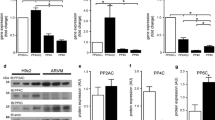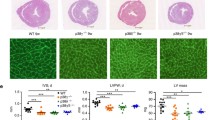Abstract
Total protein kinase C (PKC) activity, its isoform expression, and concentration and fatty acid (FA) composition of diacylglycerol (DAG) were determined in the left ventricular myocardium of the rat during early postnatal development (d 2, 3, 5, 7, and 10). PKC activity measured by the incorporation of 32P into histone IIIS decreased between d 2 and 10 in the homogenate as well as in cytosolic, membrane (100,000g), and nuclear-cytoskeletal-myofilament fractions (1000g). Likewise, the expression of PKC isoforms (α, δ, and ε) determined by immunoblotting generally declined during the period analyzed, although with a variable pattern. In the membrane and nuclear cytoskeletal myofilament fractions, PKCδ and PKCε expression decreased markedly by d 3, returning to or close to the d 2 level immediately on d 5. PKCα expression in the membrane fraction remained almost unchanged by d 7, declining thereafter. PKCδ and PKCε were associated predominantly with particulate fractions, whereas PKCα was more abundant in the cytosolic fraction. DAG concentration exhibited a significant decline by d 5, consistent with the decrease in maximal PKC activity. The unsaturation index of FA in DAG tended to decrease on d 3 owing to the lowered proportion of all polyunsaturated FA of n−6 and n−3 series. These results demonstrate that the developmental decrease in PKC activity and expression in the rat myocardium is not linear and that subcellular localization of the enzyme exhibits isoform-specific day-by-day changes during the early postnatal period. These changes are compatible with the view that PKC signaling may be involved in the control of a rapid switch of myocardial growth pattern during the first week of life.
Similar content being viewed by others
References
Nishizuka, Y. (1986) Studies and perspectives of protein kinase C. Science 233, 305–312.
Puceat, M. and Vassort, G. (1996) Signalling by protein kinase C isoforms in the heart. Mol. Cell. Biochem. 157, 65–72.
Malhotra, A., Kang, B. P., Opawumi, D., Belizaire, W., and Meggs, L. G. (2001) Molecular biology of protein kinase C signaling in cardiac myocytes. Mol. Cell. Biochem. 225, 97–107.
Sabri, A. and Steinberg, S. F. (2003) Protein kinase C isoform-selective signals that lead to cardiac hypertrophy and the progression of heart failure. Mol. Cell. Biochem. 251, 97–101.
Nishizuka, Y., (1992) Intracellular signaling by hydrolysis of phospholipids and activation of protein kinase C. Science 258, 607–614.
Newton, A. C. (1995) Protein kinase C: structure, function, and regulation. J. Biol. Chem. 270, 28,495–28,498.
Ha, K. S. and Exton, J. H. (1993) Differential translocation of protein kinase C isozymes by thrombin and platelet-derived growth factor: a possible function for phosphatidylcholinederived diacylglycerol. J. Biol. Chem. 268, 10,534–10,539.
Khan, W. A., Blobe, G. C., and Hannun, Y. A. (1995) Arachidonic acid and free fatty acids as second messengers and the role of protein kinase C. Cell. Signal. 7, 171–184.
Nishizuka, Y., (1995) Protein kinase C and lipid signaling for sustained cellular responses. FASEB J. 9, 484–496.
Murray, N. R. and Fields, A. P. (1998) Phosphatidylglycerol is a physiologic activator of nuclear protein kinase C. J. Biol. Chem. 273, 11,514–11,520.
Lee, J. Y., Hannun, Y. A., and Obeid, L. M. (1996) Ceramide inactivates cellular protein kinase C alpha. J. Biol. Chem. 271, 13,169–13,174.
Dhalla, N. S., Xu, Y. J., Sheu, S. S., Tappia, P. S., and Panagia, V. (1997) Phosphatidic acid: a potential signal transducer for cardiac hypertrophy. J. Mol. Cell. Cardiol. 29, 2865–2871.
Khan, W. A., Blobe, G. C., and Hannun, Y. A. (1992) Activation of protein kinase C by oleic acid. Determination and analysis of inhibition by detergent micelles and physiologic membranes: requirement for free oleate. J. Biol. Chem. 267, 3605–3612.
Parekh, D. B., Ziegler, W., and Parker, P. J. (2000) Multiple pathways control protein kinase C phosphorylation. EMBO J. 19, 496–503.
Newton, A. C. (1996) Trotein kinase C: ports of anchor in the cell. Curr. Biol. 6, 806–809.
Disatnik, M. H., Buraggi, G., and Mochly-Rosen, D. (1994) Localization of protein kinase C isozymes in cardiac myocytes. Exp. Cell Res. 210, 287–297.
Mochly-Rosen, D. and Gordon, A. S. (1998) Anchoring proteins for protein kinase C: a means for isozyme selectivity. FASEB J. 12, 35–42.
Clerk, A., Bogoyevitch, M. A., Fuller, S. J., Lazou, A., Parker, P. J., and Sugden, P. H. (1995) Expression of protein kinase C isoforms during cardiac ventricular development. Am. J. Physiol. Heart Circ. Physiol. 269, H1087-H1097.
Ostadal, B., Ostadalova, I., and Dhalla, N. S. (1999) Development of cardiac sensitivity to oxygen deficiency: comparative and ontogenetic aspects. Physiol. Rev. 79, 635–659.
Li, F., Wang, X., Capasso, J. M. and Gerdes, A. M. (1996) Rapid transition of cardiac myocytes from hyperplasia to hypertrophy during postnatal development. J. Mol. Cell. Cardiol. 28, 1737–1746.
Gu, X. and Bishop, S. P. (1994) Increased protein kinase C and isozyme redistribution in pressure-overload cardiac hypertrophy in the rat. Circ. Res. 75, 926–931.
Peterson, G. L. (1977) A simplification of the protein assay method of Lowry et al. which is more generally applicable. Anal. Biochem. 83, 346–356.
Ogita, K., Miyamoto, S., Yamaguchi, K., et al. (1992) Isolation and characterization of deltasubspecies of protein kinase C from rat brain. Proc. Natl. Acad. Sci. USA 89, 1592–1596.
Folch, J., Lees, M., and Stanley, G. H. (1957) A simple method for the isolation and purification of total lipids from animal tissue. J. Biol. Chem. 226, 497–509.
McGill, C. J. and Brooks, G. (1997) Expression and regulation of 80K/MARCKS, a major substrate of protein kinase C, in the developing rat heart. Cardiovasc. Res. 34, 368–376.
Herget, T., Oehrlein, S. A., Pappin, D. J., Rozengurt, E., and Parker, P. J. (1995) The myristoylated alanine-rich C-kinase substrate (MARCKS) is sequentially phosphorylated by conventional, novel and atypical isotypes of protein kinase C. Eur. J. Biochem. 233, 448–457.
Rybin, V. O. and Steinberg, S. F. (1994) Protein kinase C isoform expression and regulation in the developing rat heart. Circ. Res. 74, 299–309.
Schreiber, K. L., Paquet, L., Allen, B. G., and Rindt, H. (2001) Protein kinase C isoform expression and activity in the mouse heart. Am. J. Physiol. Heart Circ. Physiol. 281, H2062-H2071.
Hunt, R. A., Ciuffo, G. M., Saavedra, J. M., and Tucker, D. C. (1995) Quantification and localisation of angiotensin II receptors and angiotensin converting enzyme in the developing rat heart. Cardiovasc. Res. 29, 834–840.
Artman, M. (1992) Developmental changes in myocardial contractile responses to inotropic agents. Cardiovasc. Res. 26, 3–13.
Vigouroux, E. (1976) Dynamic study of postnatal thyroid function in the rat. Acta Endocrinol. (Copenh.) 83, 752–762.
Rybin, V. and Steinberg, S. F. (1996) Thyroid hormone represses protein kinase C isoform expression and activity in rat cardiac myocytes. Circ. Res. 79, 388–398.
Kazanietz, M. G., Areces, L. B., Bahador, A., et al. (1993) Characterization of ligand and substrate specificity for the calcium-dependent and calcium-independent protein kinase C isozymes. Mol. Pharmacol. 44, 298–307.
Madani, S., Hichami, A., Legrand, A., Belleville, J., and Khan, N. A. (2001) Implication of acyl chain of diacylglycerols in activation of different isoforms of protein kinase C. FASEB J. 15, 2595–2601.
Kishimoto, A., Takai, Y., Mori, T., Kikkawa, U., and Nishizuka, Y. (1980) Activation of calcium and phospholipid-dependent protein kinase by diacylglycerol, its possible relation to phosphatidylinositol turnover. J. Biol. Chem. 255, 2273–2276.
Xu, F. Y., Fandrich, R. R., Nemer, M., Kardami, E., and Hatch, G. M. (1999) The subcellular distribution of protein kinase C-alpha,-epsilon, and-zeta isoforms during cardiac cell differentiation. Arch. Biochem. Biophys. 367, 17–25.
Lamers, J. M., Dekkers, D. H., Mesaeli, N., Panagia, V., and van Heugten, H. A. (1993) Myocardial phosphoinositides do not share the same fatty acid profile. Biochem. Biophys. Res. Commun. 191, 487–494.
Ostadalova, I., Kolar, F., Ostadal, B., Rohlicek, V., Rohlicek, J., and Prochazka, J. (1993) Early postnatal development of contractile performance and responsiveness to Ca2+, verapamil and ryanodine in the isolated rat heart. J. Mol. Cell. Cardiol. 25, 733–740.
Mochly-Rosen, D., Wu, G., Hahn, H., et al. (2000) Cardiotrophic effects of protein kinase C ε: analysis by in vivo modulation of PKCε translocation. Circ. Res. 86, 1173–1179.
Chen, L., Hahn, H., Wu, G., et al. (2001) Opposing cardioprotective actions and parallel hypertrophic effects of δPKC and εPKC. PNAS 98, 11,114–11,119.
Author information
Authors and Affiliations
Corresponding author
Rights and permissions
About this article
Cite this article
Hamplova, B., Novakova, O., Tvrzicka, E. et al. Protein kinase C activity and isoform expression during early postnatal development of rat myocardium. Cell Biochem Biophys 43, 105–117 (2005). https://doi.org/10.1385/CBB:43:1:105
Issue Date:
DOI: https://doi.org/10.1385/CBB:43:1:105




